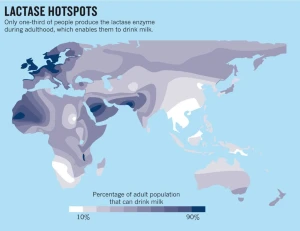From Nature:
Most people who retain the ability to digest milk can trace their ancestry to Europe, where the trait seems to be linked to a single nucleotide in which the DNA base cytosine changed to thymine in a genomic region not far from the lactase gene. There are other pockets of lactase persistence in West Africa (see Nature 444, 994–996; 2006), the Middle East and south Asia that seem to be linked to separate mutations3 (see 'Lactase hotspots').
The single-nucleotide switch in Europe happened relatively recently. Thomas and his colleagues estimated the timing by looking at genetic variations in modern populations and running computer simulations of how the related genetic mutation might have spread through ancient populations4. They proposed that the trait of lactase persistence, dubbed the LP allele, emerged about 7,500 years ago in the broad, fertile plains of Hungary.
Once the LP allele appeared, it offered a major selective advantage. In a 2004 study5, researchers estimated that people with the mutation would have produced up to 19% more fertile offspring than those who lacked it. The researchers called that degree of selection “among the strongest yet seen for any gene in the genome”.
Compounded over several hundred generations, that advantage could help a population to take over a continent. But only if “the population has a supply of fresh milk and is dairying”, says Thomas. “It's gene–culture co-evolution. They feed off of each other.”
Much of Northwestern Europe comprises difficult land for growing crops, but grows grass abundantly. Without dairying, the population density would have stayed low outside the rich river valleys, keeping this largely a fringe area, like Finland. (This lactose tolerance-centric theory of history was put forward by Irish dairy farmer/economist Raymond D. Crotty.)












